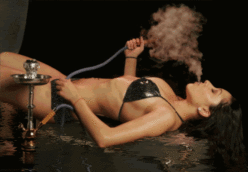The tobbaco you use to smoke is what can make or break your hookah experience. I’ll try to give you a bit of background here to help you choose what kinds you want to try first, although I encourage everyone to make it a habit to try a new ones just as often as they get the old ones. Ask for suggestions from those shopkeepers who have been smoking since they could stand up at the living room table.
Alright, firstly there are many different names for tobbaco used for this style of water pipe. This is by no means an exhaustive list, but let’s give it a try anyways: Narghile, Shisha, Sheesha, Nargile, Tobacco, Tobamel, Maasel. So there you have it, a very short list. This type of tobbaco comes in boxes and usually has some egyptian writing on the side. YOU ARE GOING TO BE SURPRISED HOW WET THIS STUFF IS! It isn’t like a cigarette, and this isn’t meant to be burnt. Shisha just warms up and then gets sucked down into the chamber, so just sit back and relax while the coals do the bizness. Truthfully, I don’t know if there is much more to say about this except to experiment and try as many as you can and don’t forget to mix them as well for interesting new flavors. Personal Note: My favorite is mint and it will clear up a cold in no time. Check out this excerpt from Wikipedia about shisha:
‚ÄúThe most commonly-used hookah tobbacos (known as tobamel or maassel) are produced using a 1:2 mixture of shredded tobacco leaf mixed in with a sweetener such as honey, molasses or semi-dried fruit. Originally, tobacco was mixed with one of these sweeteners to form jur?¢k (e.g. Zhaghoul brand), a flavorless, moistened tobacco. The now-popular, fruit-flavored hookah tobaccos got their start in the late 1980s when Egyptian tobacco companies began experimenting with flavored tobacco as a way to sell more of their products to women. Due to the popularity of flavored hookah tobaccos, many modern manufacturers have begun to use glycerin as the primary sweetener in hookah tobaccos because of its humectant qualities and subtle sweetening properties that accentuate the various tobacco flavorings. Today, shisha tobacco is often mixed with dried fruit, natural extracts and artificial flavorings to produce a varying assortment of tobacco flavors, such as apple, double and triple apple, strawberry, mango, cappuccino, vanilla, coconut, cherry, grape, banana, kiwi, blueberry, tuti fruity, Arabian coffee, mixed fruit, cola, lemon, apricot, licorice, and mint, which has a cooling effect on the throat. This proliferation of flavors is rather new, starting perhaps in the mid-1990s.‚Äù
Thanks to Wikipedia for parts of the above info…

I am a U.S. Marine, and I have been collecting Hookahs from all over the world. I can’t get my fix. I have Hookah’s from Kazakhstan, Turkmenistan, Saudi Arabia, United Arab Emirates, Turkey, Russia, Japan, Iraq, and I will be going to Bosnia next, and I would be wrong of me not to keep up the tradition. I have all shapes, sizes, and colors. The goal was to collect as many different and unique types of Hookah’s. For those of you who are not seasoned smokers, here is some interesting info that may help you find a local smoke pub in other countries. Hookah has many names all around the world like hubbly bubbly, Hookah, Shisha, Tobac, Sheesha, and the Russian slang term is –?–?–ª—å—è–?, which in English is translated to Calion. These terms will make you at least sound like a pro. But you can’t just go by a hookah and think you know what your doing, you can be as creative as you want but be sure to master the basics first. Also just as important tobacco is everything. I get mine on the streets of Jeddah, Saudi Arabia as well as import some from Kabul, Afghanistan. When I get back to the United States I would love to open an amazing Hookah lounge, I have the hookups to import the best tobacco from around the world for cheap and have great ideas on making this a place unlike any other in the United States. I just need to find some sponsorship and this dream can come true.